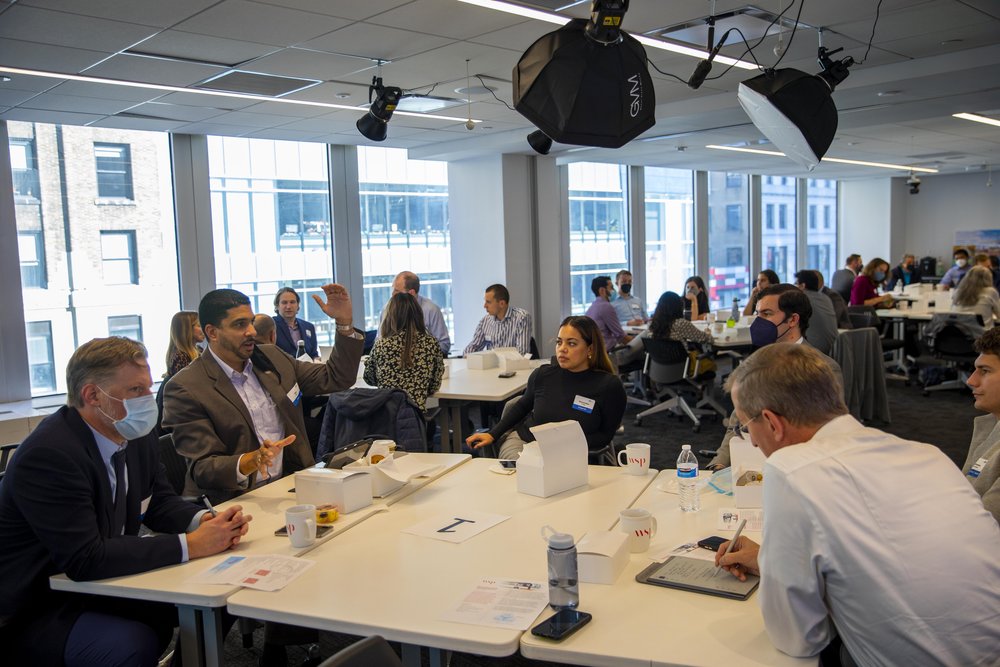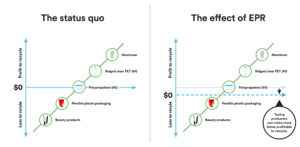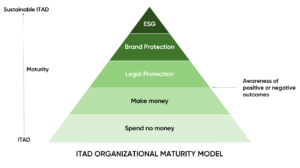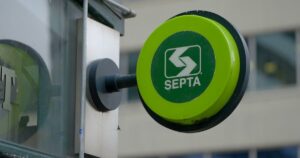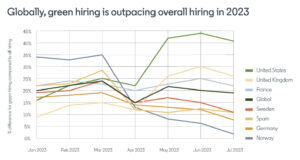H.G. Chissell, founder and CEO of Advanced Energy Group, launched the company in 2014 to create a model for stakeholder engagement that goes beyond the typical model — with the goal of helping cities deliver on climate, health and equity promises.
Originally known as Chicago Advanced Energy, AEG is a for-profit, minority-owned enterprise sponsored by public and private organizations. Based outside Philadelphia, it provides quarterly and annual stakeholder action challenges in Boston, Chicago, Miami, New York City, Washington, D.C. and San Juan, Puerto Rico.
“I saw no infrastructure for the type of dialogue necessary to be successful,” Chissell said. “There was no real environment that I saw that existed where the right diversity of stakeholders who all have a true vested interest in success [was present].”
The stakeholder participants and presenters at the action challenges represent cities, utilities, regulators, national energy labs, community-based sustainability groups and entrepreneurs. To date, AEG has engaged participation from more than 60 corporations, government agencies and social change organizations — all in pursuit of its mission to generate solutions that look beyond hard numbers and metric tons to achieve systemic change at the intersection of energy and equity.
The AEG Stakeholder Challenge is a three-part competition conducted every year in host cities. AEG also designed and facilitates Puerto Rico Energy Week, held each February in San Juan. Stakeholder challenges follow a quarterly schedule, with each challenge focusing on a specific sustainability: Climate change mitigation or clean energy is the focus during the first quarter; followed by critical infrastructure, equity and resilience (Q2); buildings and construction, grid modernization (Q3); and clean transportation (Q4). Other cities on AEG’s agenda for stakeholder challenges in 2023 include Atlanta, Houston, Miami and San Jose, California.
A lot of stakeholder engagement, and I almost want to put it in quotes, is about following prescribed pathways or existing power structures.
Each stakeholder challenge is comprised of collaborative discussion to identify a critical obstacle to achieving social equity and clean energy transition, chosen by consensus among the participants. Further discussion generates a selected course of action to pursue over the next 12 months that is designed to address the obstacle. Finally, a cross-sector, all-volunteer task force comprised of stakeholder participants is tasked with developing the solution. Quarterly accountability milestones are meant to ensure task force remains on track to achieve the goals associated with overcoming their assigned obstacle.
“A lot of stakeholder engagement, and I almost want to put it in quotes, is about following prescribed pathways or existing power structures. So, commissions have dockets and proceedings, but those don’t really engage the people that need to be a part of this, [the people] who it affects the most. You see that at many conferences, but I needed to find a way to turn it[around] and not be a conference, but actually a growing, constructive dialogue.
“When I see 12, 15, 18 people in a room raise their hand, and come up and say, ‘I’m going to be on this task force to deliver this, hold myself accountable as a member of this team’, I know I’m doing something worthwhile,” Chissell said.
Real-world outcomes
The 2021 Q3 grid modernization stakeholder challenge in New York City has been associated with one of the most consequential on-the-ground results to date.
The chosen obstacle for the challenge focused on Hunts Point, a produce and meat market located in the South Bronx. As the largest food distribution center in the country, Hunts Point supplies much of New York City. The warehouse district, surrounded by multi-story public housing units, is known as Asthma Alley. That’s largely due to the fact that refrigerated trucking units have been stationed at various points across the property, idling diesel fuel 24/7 to compensate for the lack of adequate cold storage at the site. The available infrastructure was inadequate to support a switch to electric refrigerated trucking units.
During the stakeholder challenge, David Sandbank, vice president of distributed energy at the New York State Energy Research and Development Authority (NYSERDA), posed this call to action: “Aligning city and state goals with markets, industry and all stakeholders to expedite critical grid upgrades to enable beneficial electrification projects, such as Hunts Point.” The participants opted to create a report that quantified energy usage at Hunts Point, along with health and environmental impacts to the community — and which included a set of recommendations for next steps.
“[Sandbank] inspired the entire room to get behind him. You felt like you were in the emergency room really trying to solve this problem. An incredible task force stood up to address the issue, including key leaders from Con Edison, the Power Authority [NYPA], all the players. A director of air quality [at the New York City Health Department] started running studies to see what the health implications were of not solving this problem. And ultimately, together they visited Hunts Point; they did a site visit. They found one of the produce distributors at the market to get involved. So, this relates to how do we build out the electric infrastructure at Hunts Point? All the key stakeholders started coming in,” Chissell said.
In September, Hunts Point was awarded $110 million through a U.S. Department of Transportation Infrastructure for Rebuilding America grant to upgrade and improve its facilities. And on page 161 of her 2022 State of the State Report, Gov. Kathy Hochul announced that she would “direct an interagency team led by NYSERDA and [New York Power Authority] to develop solutions to transform Hunts Point Food Market into a Clean Distribution Hub,” including critical upgrades in electrical grid infrastructure to eliminate the need for diesel trucks to provide adequate cold storage capacity.
“It just brought this back to being a human issue. And it was really powerful to be a part of that and start to have the right language to get people inspired to do something. I feel like this task force has had an essential role in making that happen. Now that they [Hunts Point] have this money, they have a real chance at reducing avoidable death in that area,” Chissell said.
Establishing and maintaining collaboration and representation
In expanding the reach of AEG, Chissell crisscrossed the continent, initially as a side gig to his full-time job at Viridity Energy, committing himself to conducting challenges in Chicago, New York City and Washington, D.C. In New York, Chissell worked as the point person for a Department of Energy demonstration grant for Con Edison. He also had connections with a number of New York City real estate owners, which made the Big Apple a natural for conducting stakeholder challenges.
Chissell had also conducted a lot of work with the Department of Defense, which made Washington, D.C., a logical new location for stakeholder challenges. Stakeholder challenges in Boston were originally assigned to someone else, but Chissell wound up taking on the duties of that city as well.
Chissell has also been intentional in ensuring that each stakeholder challenge is representative across industries and demographics for both invited speakers and participants who request invitations to attend stakeholder challenges.
“If you’re going to say as a sponsor that you care about equity, then make sure you’re recommending leaders in your company of color and women to be in the room. I will tell sponsors, I’m not going to have an all-white male panel. When we talk about things like transportation and equity, how is that going to give us the full experience? And I hold myself accountable to have that room and be reflective of the populations in which we’re trying to create positive change,” Chissell said.
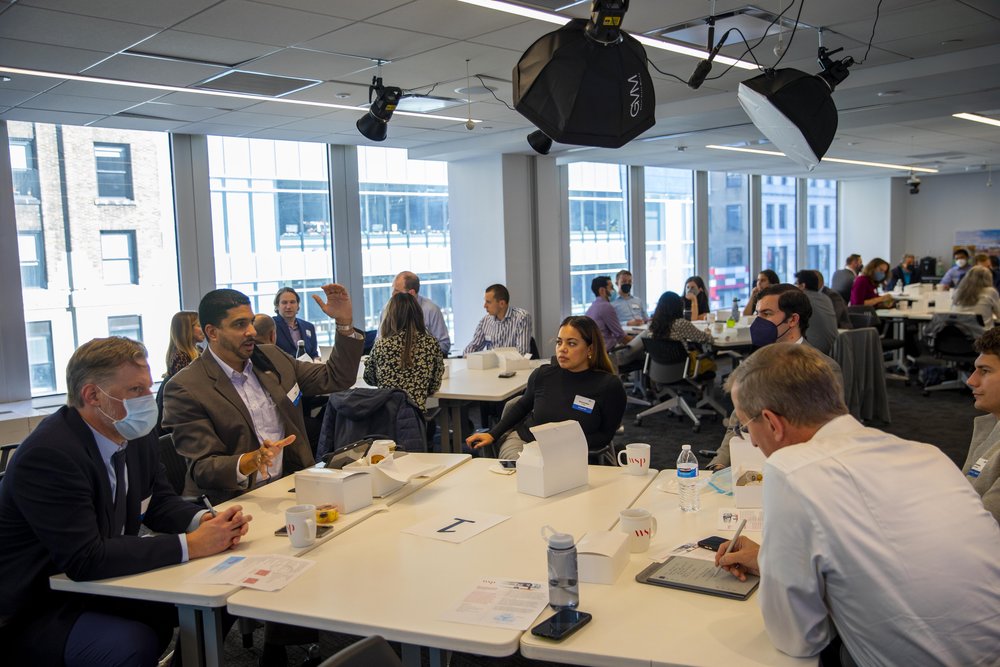
![]()
![]()
![]()
Stakeholder challenges
At each stakeholder challenge, invited speakers present brief lightning talks to the entire group, addressing a specific obstacle to achieving progress toward the assigned quarterly stakeholder challenge topic. Participants are seated at tables of small groups to facilitate discussion. After the presentations, participants at each table engage in discussion to select the obstacle they believe the entire group should address. A consensus vote by all participants determines the chosen obstacle to be addressed by a working task force over the next 12 months.
After a target obstacle is selected, each table crafts a plan to address it. After all tables have completed their presentations, a representative from each table presents its solution. A second consensus vote selects one idea as a framework to address over the next 12 months.
Finally, a group of volunteers commits to participating in a working task force to apply the selected solution toward addressing the chosen obstacle. The task force has an obligation to interact on regular intervals — and to present a progress report at the end of the 12 months. During that follow-up gathering, participants vote to determine whether the task force has met the assignment.
The stakeholder challenges organized by AEG are conducted under the Chatham House Rule, which prohibits public disclosure or attribution of specific statements made during the event by other participants, although participants are free to disclose their own statements. Members of the press, while not prohibited from attending, must also adhere to the Rule. This approach is intended to encourage a free flow of dialogue among stakeholder challenge participants.
Establishing a collaborative environment and maintaining momentum and commitment over the 12-month period is an ongoing challenge, Chissell said.
“When you work to bring people together to start that conversation, you can’t do it once. You have to commit to building a conversation. Not only is it hard to get people in a room that represent all the key components you need for a conversation on systemic change, it’s also hard to get people wanting to come back quarter after quarter. But I feel if you don’t do that, you really don’t foster alignment and consensus to get things done,” Chissell said.
When you work to bring people together to start that conversation, you can’t do it once. You have to commit to building a conversation.
AEG’s programming, logistics and operation are supported by annual sponsorships made by public and private organizations. Task forces that result from AEG Stakeholder Challenges are composed of leaders who volunteer their time for 12 months to deliver a concrete impact upon an agreed obstacle. Sponsor support also allows AEG to provide resources to task forces, including marketing support and related registration and other logistics. Chissell often serves as support facilitator for task force conference calls or Zoom meetings.
AEG Fellows, who are graduate students and advanced undergraduates, provide coordination support for each task force. Fellows reach out to task force members by emails to arrange twice-monthly conferences by phone or Zoom and post progress reports. This interaction provides AEG Fellows an opportunity to develop authentic relationships with a wide range of senior level leaders.
Moving forward
Much of the work of AEG is highlighted on its website, as well as on its YouTube channel and on Instagram. Moving forward, Chissell would like to extend the outreach and impact of AEG task force results via white papers and by encouraging task force members to speak at relevant conferences. He is also recruiting facilitators for stakeholder challenges to allow for expansion to more locations. Chissell is especially enthusiastic about the prospect of creating an engagement model based on case studies from stakeholder challenges that could be adapted to an educational curriculum with educational credit as a means of bringing more young people into the field.
“So, whether you’re in a graduate program and you want your students to take on how to solve a real problem and approaches, we’ve got a great format for a capstone with this approach. The obstacle, the proposed solution, the task force, the timeline of 12 months, that could be put into a template that could go to graduate schools, it could go to colleges committed to solving on sustainability and energy issues. It even could go to high schools because it’s not overly complicated the way we’re presenting this,” Chissell said.
Disclosure: I attended the 2022 Q4 stakeholder challenge in Chicago as an observer, at the invitation of H.G. Chissell. One speaker, Arthur Burton of AMB Renewable Energy was invited as a presenter after Chissell read a profile I wrote about Burton and his company for Energy News Network. Burton’s obstacle was selected for the task force to address during the next 12 months. I disclosed my status as a working journalist to the other participants at my table. I also refrained from engaging in active participation during the challenge, in observance of the Chatham House Rule and adherence to general journalism ethics.
- SEO Powered Content & PR Distribution. Get Amplified Today.
- Platoblockchain. Web3 Metaverse Intelligence. Knowledge Amplified. Access Here.
- Source: https://www.greenbiz.com/article/how-aeg-connects-corporations-and-other-stakeholders-help-cities-deliver-climate-goals
- 12 months
- 2014
- 2021
- 2022
- 2023
- 7
- a
- About
- accountability
- Achieve
- achieving
- across
- Action
- active
- actually
- adapted
- address
- addressing
- adhere
- advanced
- After
- agencies
- agenda
- AIR
- All
- allows
- Although
- america
- among
- and
- announced
- annual
- Apple
- Apply
- approach
- approaches
- AREA
- around
- Arthur
- assigned
- associated
- Atlanta
- attend
- attending
- Authentic
- authority
- available
- awarded
- back
- based
- because
- behind
- being
- believe
- beneficial
- Beyond
- Big
- boston
- bring
- Bringing
- brought
- build
- Building
- california
- call
- call to action
- Calls
- Capacity
- care
- case
- Case Studies
- Center
- ceo
- challenge
- challenges
- Chance
- change
- Channel
- chicago
- chosen
- Cities
- City
- clean energy
- Climate
- Climate change
- Cold Storage
- collaboration
- collaborative
- Colleges
- color
- come
- coming
- commissions
- commit
- commitment
- committed
- committing
- community
- company
- competition
- Completed
- complicated
- components
- composed
- Comprised
- conducting
- Conference
- conferences
- Connections
- connects
- Consensus
- construction
- continent
- Conversation
- coordination
- Corporations
- could
- country
- course
- create
- Creating
- credit
- critical
- Critical Infrastructure
- Curriculum
- D.C.
- data
- Date
- David
- Death
- Defense
- deliver
- Demographics
- Department
- department of defense
- Department of Energy
- department of transportation
- designed
- Determine
- determines
- develop
- developing
- Development
- dialogue
- DID
- diesel
- direct
- Director
- Disclose
- disclosure
- discussion
- distributed
- distribution
- distributors
- district
- Diversity
- doing
- during
- each
- Edison
- educational
- Electric
- eliminate
- emails
- emergency
- enable
- encourage
- encouraging
- energy
- engage
- engaged
- engagement
- engaging
- ensure
- ensuring
- Enterprise
- enthusiastic
- Entire
- entrepreneurs
- Environment
- environmental
- equity
- especially
- essential
- estate
- Ether (ETH)
- ethics
- Even
- Event
- Every
- existing
- expanding
- expansion
- experience
- extend
- facilitate
- facilitates
- facilities
- February
- field
- Finally
- Find
- First
- flow
- Focus
- focused
- focusing
- follow
- followed
- following
- food
- Force
- Forces
- format
- Forward
- Foster
- found
- founder
- Founder and CEO
- Framework
- Free
- from
- Fuel
- full
- further
- gathering
- General
- generate
- generates
- get
- Give
- Go
- goal
- Goals
- Goes
- going
- Government
- Governor
- graduate
- grant
- great
- Grid
- Group
- Group’s
- Growing
- happen
- Hard
- Health
- Held
- help
- helping
- High
- high schools
- Highlighted
- hold
- host
- House
- housing
- houston
- How
- How To
- HTTPS
- Hub
- human
- idea
- identify
- Impact
- Impacts
- implications
- improve
- in
- include
- included
- Including
- incredible
- industries
- industry
- Infrastructure
- initially
- inspired
- Intentional
- interact
- interaction
- interest
- intersection
- invitation
- involved
- issue
- issues
- IT
- Job
- journalism
- journalist
- Kathy Hochul
- Key
- Know
- known
- Labs
- Lack
- language
- largely
- largest
- launched
- leaders
- Led
- Level
- lightning
- located
- location
- locations
- logical
- logistics
- Look
- Lot
- made
- make
- Making
- many
- Market
- Marketing
- Markets
- means
- Meat
- meetings
- member
- Members
- metric
- Miami
- Milestones
- Mission
- mitigation
- model
- modernization
- Momentum
- money
- months
- more
- most
- move
- moving
- National
- Natural
- necessary
- Need
- needed
- network
- New
- New York
- new york city
- New York state
- news
- next
- number
- numbers
- NY
- NYC
- obstacle
- ONE
- ongoing
- operation
- Opportunity
- organizations
- Organized
- originally
- Other
- Other participants
- outreach
- outside
- own
- owners
- panel
- papers
- part
- participants
- participating
- participation
- People
- period
- person
- philadelphia
- phone
- plan
- plato
- Plato Data Intelligence
- PlatoData
- players
- Point
- points
- populations
- positive
- Post
- power
- powerful
- present
- presentation
- Presentations
- presents
- president
- press
- private
- Problem
- Proceedings
- produce
- Program
- Programming
- Progress
- projects
- promises
- property
- proposed
- prospect
- provide
- provides
- public
- Puerto
- Puerto rico
- pursue
- put
- Q2
- Q3
- quality
- Quarter
- raise
- range
- RE
- reach
- Read
- real
- real estate
- recommendations
- recommending
- recruiting
- reducing
- Registration
- regular
- Regulators
- related
- Relationships
- relevant
- remains
- Renewable
- renewable energy
- report
- Reports
- represent
- representative
- request
- research
- research and development
- resilience
- Resources
- result
- Results
- RICO
- Role
- Room
- Rule
- running
- Said
- San
- San Jose
- schedule
- Schools
- Second
- selected
- senior
- September
- serves
- set
- should
- site
- small
- So
- Social
- Social Change
- solution
- Solutions
- SOLVE
- Solving
- Someone
- something
- South
- speak
- Speaker
- speakers
- specific
- sponsor
- Sponsored
- Sponsors
- stakeholder
- stakeholders
- start
- started
- State
- statements
- Status
- Steps
- storage
- Students
- studies
- success
- successful
- such
- support
- Supported
- surrounded
- Sustainability
- Switch
- systemic
- table
- Take
- taking
- Talk
- Talks
- Target
- Task
- task force
- team
- template
- The
- The State
- their
- things
- Through
- time
- timeline
- to
- together
- tons
- topic
- toward
- track
- Transform
- transition
- transportation
- Trucking
- Trucks
- true
- TURN
- typical
- u.s.
- Ultimately
- under
- units
- upgrade
- upgrades
- us
- Usage
- utilities
- various
- Ve
- via
- Vice President
- visited
- volunteer
- volunteers
- Vote
- wanting
- Warehouse
- washington
- Website
- week
- What
- whether
- which
- while
- white
- WHO
- wide
- Wide range
- will
- Women
- Work
- worked
- working
- worthwhile
- would
- year
- young
- Your
- youtube
- zephyrnet
- zoom

